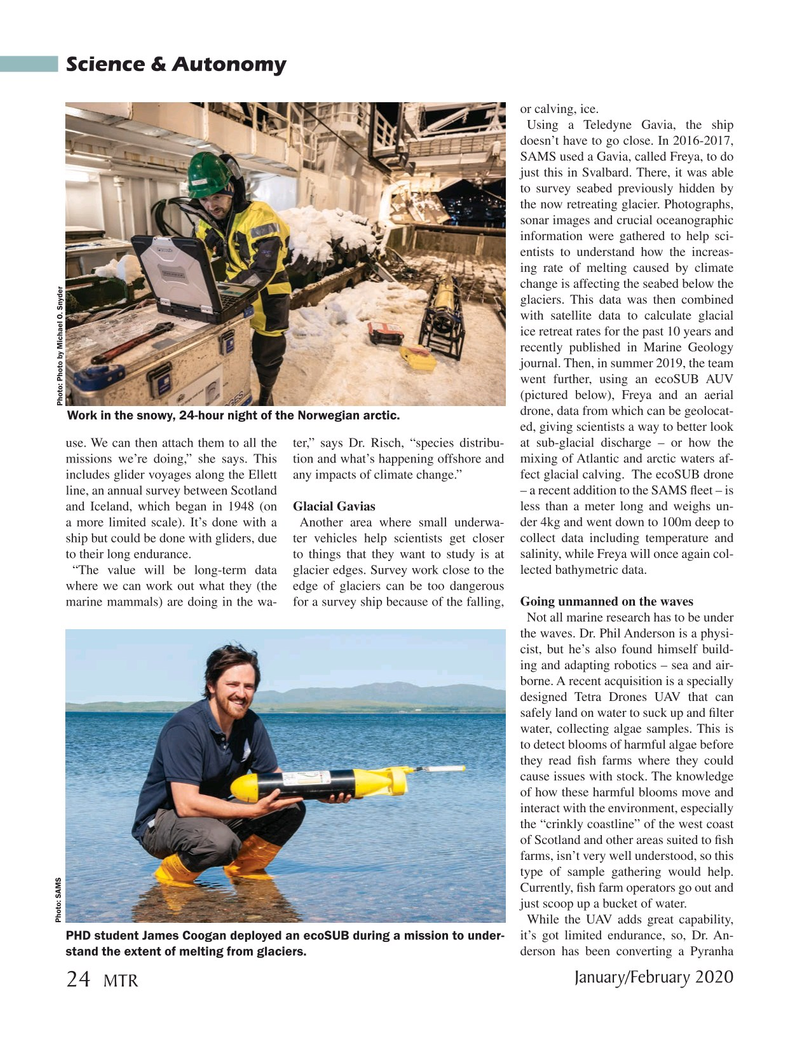
Page 24: of Marine Technology Magazine (January 2020)
Read this page in Pdf, Flash or Html5 edition of January 2020 Marine Technology Magazine
Science & Autonomy or calving, ice.
Using a Teledyne Gavia, the ship doesn’t have to go close. In 2016-2017,
SAMS used a Gavia, called Freya, to do just this in Svalbard. There, it was able to survey seabed previously hidden by the now retreating glacier. Photographs, sonar images and crucial oceanographic information were gathered to help sci- entists to understand how the increas- ing rate of melting caused by climate change is affecting the seabed below the glaciers. This data was then combined with satellite data to calculate glacial ice retreat rates for the past 10 years and recently published in Marine Geology journal. Then, in summer 2019, the team went further, using an ecoSUB AUV (pictured below), Freya and an aerial
Photo: Photo by Michael O. Snyder drone, data from which can be geolocat-
Work in the snowy, 24-hour night of the Norwegian arctic. ed, giving scientists a way to better look use. We can then attach them to all the ter,” says Dr. Risch, “species distribu- at sub-glacial discharge – or how the missions we’re doing,” she says. This tion and what’s happening offshore and mixing of Atlantic and arctic waters af- includes glider voyages along the Ellett any impacts of climate change.” fect glacial calving. The ecoSUB drone line, an annual survey between Scotland – a recent addition to the SAMS ? eet – is and Iceland, which began in 1948 (on Glacial Gavias less than a meter long and weighs un- a more limited scale). It’s done with a Another area where small underwa- der 4kg and went down to 100m deep to ship but could be done with gliders, due ter vehicles help scientists get closer collect data including temperature and to their long endurance. to things that they want to study is at salinity, while Freya will once again col- “The value will be long-term data glacier edges. Survey work close to the lected bathymetric data.
where we can work out what they (the edge of glaciers can be too dangerous marine mammals) are doing in the wa- for a survey ship because of the falling, Going unmanned on the waves
Not all marine research has to be under the waves. Dr. Phil Anderson is a physi- cist, but he’s also found himself build- ing and adapting robotics – sea and air- borne. A recent acquisition is a specially designed Tetra Drones UAV that can safely land on water to suck up and ? lter water, collecting algae samples. This is to detect blooms of harmful algae before they read ? sh farms where they could cause issues with stock. The knowledge of how these harmful blooms move and interact with the environment, especially the “crinkly coastline” of the west coast of Scotland and other areas suited to ? sh farms, isn’t very well understood, so this type of sample gathering would help.
Currently, ? sh farm operators go out and just scoop up a bucket of water.
Photo: SAMS
While the UAV adds great capability,
PHD student James Coogan deployed an ecoSUB during a mission to under- it’s got limited endurance, so, Dr. An- stand the extent of melting from glaciers. derson has been converting a Pyranha
January/February 2020 24 MTR
MTR #1 (18-33).indd 24 1/16/2020 11:25:52 AM

 23
23

 25
25
